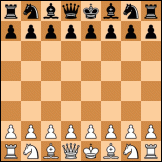Ugly position for my eyes! I must admit that I do not like these kind of positions... but challenge was accepted. Spark solved it!Uri Blass wrote:I remember that leonid posted hard mates for chess engines.Spliffjiffer wrote:Yes...after 4.Qg2 there are some lines which not end in the Qa8,Qg8# maneuver...ty for clarification.
The mainline of Bogoljubow's solution was: 1.d3 cd 2.Rf4 gf 3.Ra4 Bxa4 4.Qg2 a1Q 5.Ng6 fg 6.Qa8 and 7.Qg8#
From my human point of view this line is the most obvious (even so for strelka it seems )
The first two times this problem was published ( "Deutsche Schachzeitung"and then "The Problemist") it were not solved by anyone.
Only the third time there were two correct solutions.
For a human (well the humans i know) the 1.d3 move seems nearly unfindable...and even the engines have their problems to find it quickly (instead of matesolving software).
Btw....does anyone know a problem with mate in 7 moves without zugzwang-elements for which an engine (lets say houdini, critter, stockfish, rybka) takes longer than this one?
...a hard task i think.
Regards from germany
Here is an example
This does not seem to be good enough but maybe another position if leonid is good enough(stockfish2.2.2 4 cpu could find the mate in 31 seconds) but maybe a different position of leonid is good enough.
http://www.stmintz.com/ccc/index.php?id=154354
[d]rQ1Q1rnk/q4qbp/3nQqbB/q1Q1NnNn/5QQ1/b2Q4/1QB3Q1/1K1R3R w - -
1.Ngxf7+ Nxf7 2.Nxg6+ hxg6 3.Bxg7+ Nfxg7 4.Qgxh5+ Nxh5 5.Qfxf6+ Ngxf6 6.Qdxf8+ Kh7 7.Qgxg6#
Analysis by Spark 1.0 w32 (using two cores) in an Intel Pentium D930 (3GHz), with 128 MB of hash, running under Arena 2.0.1 GUI:
The suggested line is different to yours but also valid.FEN: rQ1Q1rnk/q4qbp/3nQqbB/q1Q1NnNn/5QQ1/b2Q4/1QB3Q1/1K1R3R w - - 0 1
Spark-1.0-win32-mp:
1 00:00 49.423 210.310 -2,50 Ne5f3
1 00:00 75.286 209.127 -2,45 Ne5c4
1 00:00 80.022 204.659 -2,44 Ne5c6
1 00:01 219.235 200.397 -0,64 Ne5xg6+ Qf7xg6 Bh6xg7+ Qa7xg7 Qd8xf6
1 00:03 678.820 215.020 +3,23 Ne5xf7+ Qa7xf7 Ng5xf7+ Qf6xf7 Bh6xg7+ Nf5xg7 Qe6xf7
2/2 00:03 683.166 215.373 +3,23 Ne5xf7+ Qa7xf7 Ng5xf7+ Qf6xf7 Bh6xg7+ Nf5xg7 Qe6xf7
2/2 00:09 2.024.286 212.724 +7,51 Ng5xf7+ Qa7xf7 Bh6xg7+ Qf7xg7 Ne5xg6+ Qg7xg6 Qb2xf6+ Nh5xf6 Qg4xg6
3/4 00:09 2.025.656 212.511 +7,51 Ng5xf7+ Qa7xf7 Bh6xg7+ Qf7xg7 Ne5xg6+ Qg7xg6 Qb2xf6+ Nh5xf6 Qg4xg6
4/8+ 00:09 2.033.705 212.663 +7,76 Ng5xf7+ Qa7xf7
4/8+ 00:09 2.054.719 213.477 +8,01 Ng5xf7+ Qa7xf7
4/8+ 00:09 2.067.391 213.750 +9,01 Ng5xf7+ Qa7xf7
4/8 00:09 2.091.186 213.778 +9,42 Ng5xf7+ Qa7xf7 Bh6xg7+ Nh5xg7 Rh1xh7+ Bg6xh7 Qg4xg7+ Qf7xg7 Qg2xg7+ Qf6xg7 Qd8xa5
5/10+ 00:10 2.183.635 215.987 +9,67 Ng5xf7+ Qa7xf7
5/10+ 00:10 2.186.875 216.308 +9,92 Ng5xf7+ Qa7xf7
5/10 00:10 2.207.480 217.015 +10,77 Ng5xf7+ Qa7xf7 Bh6xg7+ Nf5xg7 Ne5xg6+ Qf6xg6 Qd3xg6 Nd6e4 Qg4xh5 Ng8f6 Qg6xf7
6/14+ 00:10 2.298.524 219.220 +11,02 Ng5xf7+ Qa7xf7
6/14+ 00:10 2.304.043 219.432 +11,27 Ng5xf7+ Qa7xf7
6/14+ 00:10 2.447.401 224.388 +17,27 Ng5xf7+ Qa7xf7
6/14+ 00:11 2.487.288 225.155 +23,27 Ng5xf7+ Nd6xf7
6/14 00:12 3.372.698 266.806 +M8 Ng5xf7+ Qa7xf7 Bh6xg7+ Nf5xg7 Qd3xg6 h7xg6 Ne5xg6+ Qf7xg6 Qe6xg8+ Kh8xg8 Qd8xf8+ Qf6xf8 Qf4xf8+ Kg8h7 Qf8h8+
7/15 00:57 24.875.788 434.982 +M7 Ng5xf7+ Qa7xf7 Bh6xg7+ Nf5xg7 Qg4xh5 Ng7xh5 Ne5xf7+ Nd6xf7 Qf4xf6+ Nh5xf6 Qe6xf6+ Ng8xf6 Qd8xf8+
Very good eval and pruning are basic here because there are tons of possible moves. Lots of engines crash or do nothing in this position... I guess that it is due to the high number of legal moves at first ply (142 here). Maybe those engines support a maximum of 127 different moves at depth 1, while 255 would fix those crashes (it is just a random guess).
Code: Select all
JetChess 1.0.0.0:
FEN: rQ1Q1rnk/q4qbp/3nQqbB/q1Q1NnNn/5QQ1/b2Q4/1QB3Q1/1K1R3R w - - 0 1
Perft(1) = 142
Perft(2) = 7,351
Perft(3) = 967,374
Perft(4) = 52,841,538
Perft(5) = 6,518,020,904
Perft(6) = 373,415,809,086Regarding the number of unique positions after each ply:
Code: Select all
JetChess 1.0.0.0:
FEN: rQ1Q1rnk/q4qbp/3nQqbB/q1Q1NnNn/5QQ1/b2Q4/1QB3Q1/1K1R3R w - - 0 1
Positions(1) = 142
Positions(2) = 7,351
Positions(3) = 546,555
Positions(4) = 16,653,458Regards from Spain.
Ajedrecista.
